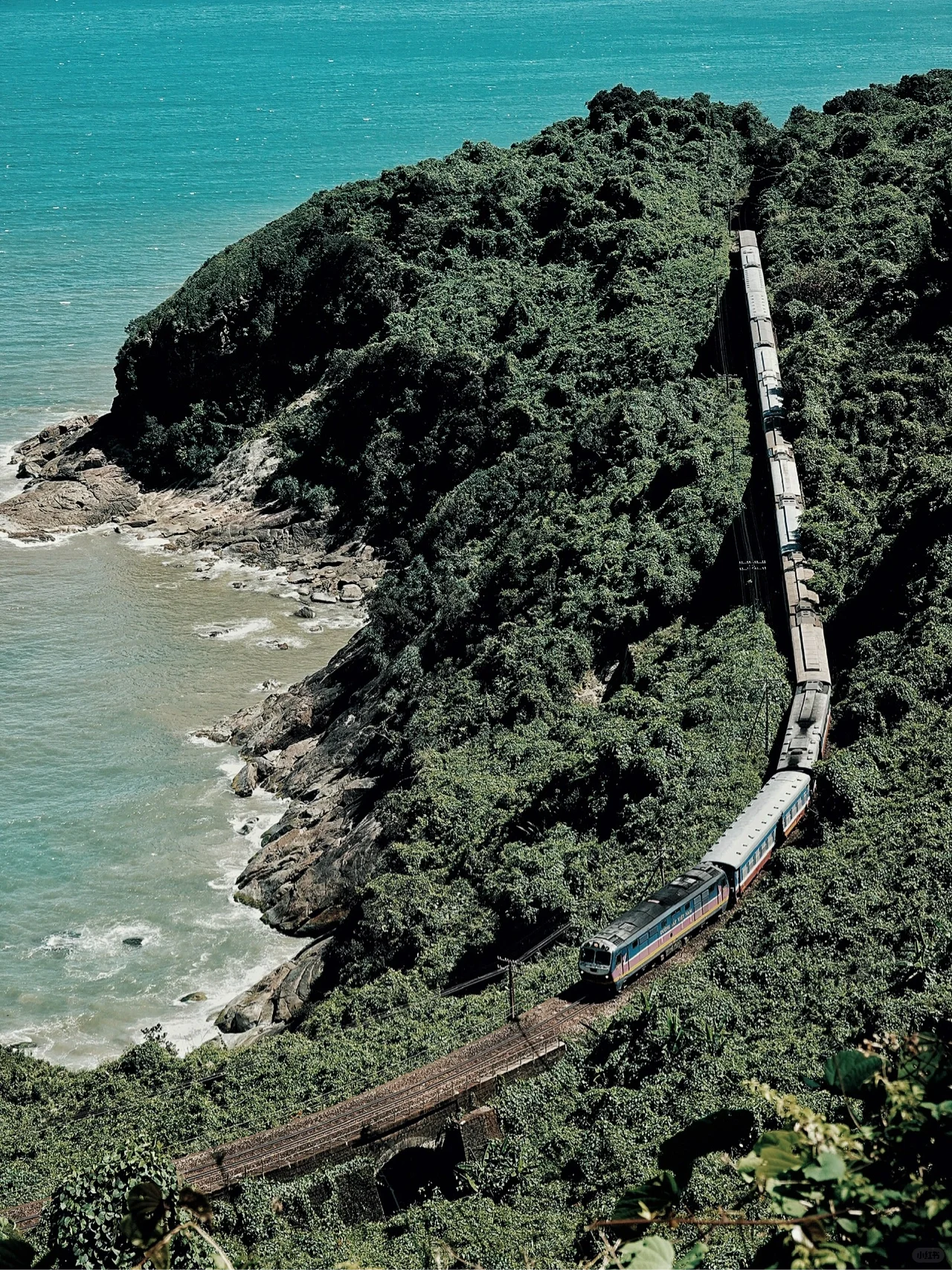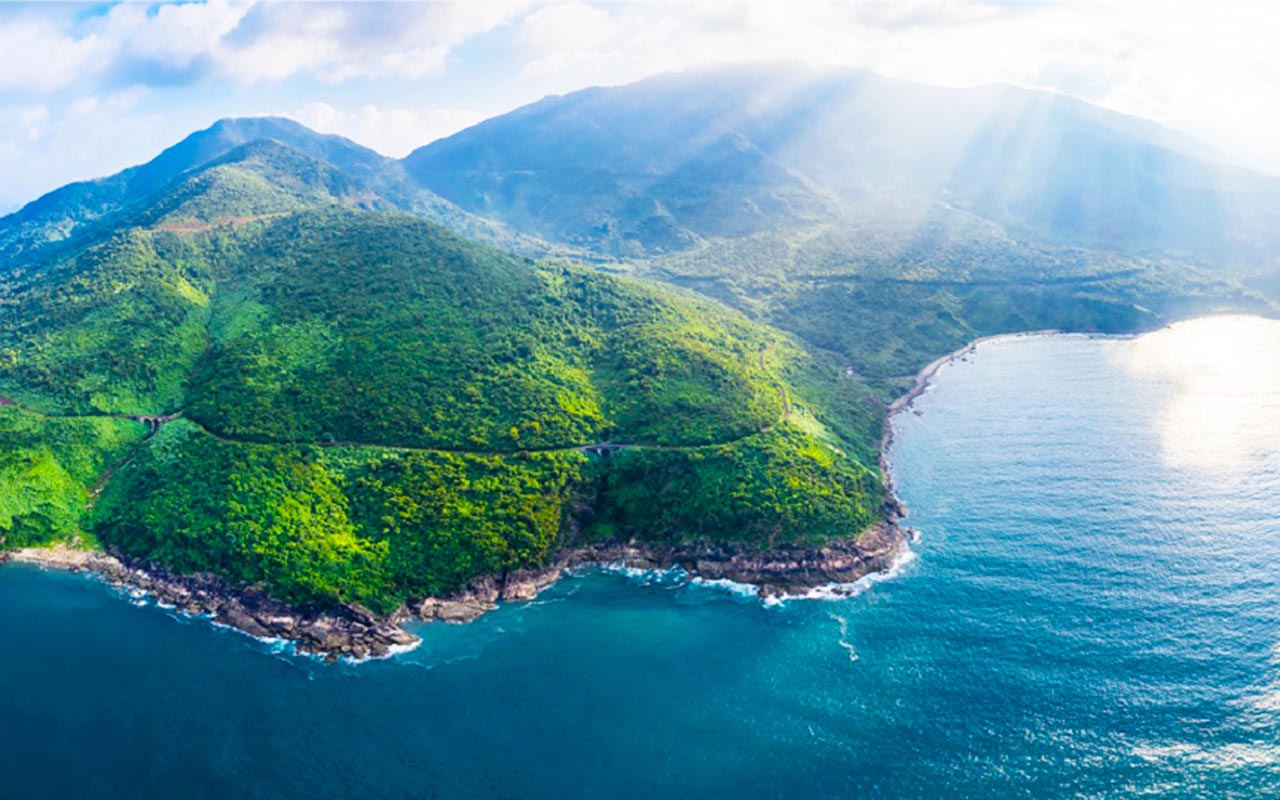If you’re reading this, you’ve probably already seen our Taiwan Alishan Forest Railway scenic guide and are looking for more scenic train rides around the world that you can take.
Our Southeast Asian neighbours have plenty of hidden gems that we have yet to explore — like Vietnam’s coastline railway from Da Nang to Hue, which will fill your sight with endless stretches of the deep blue sea, with the pristine white beaches on one side and towering mountains on the other.

The route from Da Nang to Hue is part of the Reunification Express line that connects the capital in the north, Hanoi, with the metropolis in the south, Ho Chi Minh City.
It is one of the world’s most scenic train lines, and if you’re willing to ride coast to coast on this line, you can get to see the entirety of what stunning vistas Vietnam has to offer.

The journey from Hanoi to Ho Chi Minh city will take you two days, but the ride from Da Nang to Hue will only take up two and a half to three hours of your time and treat you to some of the best views along the Reunification Express.
Overview of the train ride between Da Nang & Hue
You can begin your journey from either Da Nang or Hue Train Station. As you travel further, the urban surroundings will gradually give way to the open expanse of the countryside, where vast green paddy fields and rolling mountains will unfold before you.

You’ll spot quaint fishing villages, farmers in conical hats tending to crops and animals grazing peacefully in green fields as the train makes its way towards Hai Van Pass.
Hai Van Pass is the highlight of this route, and where the train will spend most of its time winding through. The train speed slows to 15km/h due to many curves and difficult terrain on the Pass, which will give you more time to appreciate the beautiful views.

The pass has been featured in both Top Gear and famous American writer Paul Theroux’s The Great Railway Bazaar for its incredible views of the South China Sea, and famous crescent-shaped beach that makes up most of the photos you see online.

That being said, the best time to visit is during the summer months of April to July where there is less chance of rainfall and mist blocking your view.
Generally, the Hai Van Pass is a great ride between January to September — especially during the flowering season — but you should avoid going during the rainy season from October to December.
How to secure the best seats on the train

Turns out, many miss out on the lovely views by booking the wrong seats. Only one side of the train will be facing the sea, while the other will have a view of the (beautiful, but not as interesting) mountains.
If you’re taking the train from Da Nang to Hue, grab a seat from rows 1 and 2 as shown in the picture below. If you’re travelling from Hue to Da Nang, book a seat from rows 3 and 4.

Aim for the trains that run during sunrise and sunset — the sky will be awash with brilliant hues of pink, red and purple that contrast with the blue seas, and even the mountains will turn gold under the rays of the sun.
There are only four to five scheduled trains servicing Da Nang and Hue, and prices can fluctuate based on the number of seats left. It’s best if you book your seats a couple days earlier so you can have your pick of seats and get the best prices.

You can book your seats directly from the official Vietnam Railways (Đường sắt Việt Nam or DSVN for short) website here.
Searching for the train tickets on Google will not show you the official website, but instead the first few results are booking pages run by third-party agencies (e.g. vietnam-railway.com, vietnamrailwaycorp.com) that will charge an extra commission fee from you.

Simply click on the top-right tab of the DSVN website to change the language to English or use your trusty Google Translate. If you’re too lazy to wrangle with the translation functions, you can book on reputable English websites like Baolau or 12Go Asia for a small fee.
You can also buy tickets directly from the train stations, but be prepared as not all service staff are fluent in English.

There are four different types of seating available. The most budget-friendly is Hard Seat, featuring wooden benches and no air-conditioning. However, these cars have windows that open, which can be advantageous for photographers.
Next is Soft Seat, where you get to rest on softer vinyl chairs and enjoy air-conditioning. There are also Soft Bed and Hard Bed options for those who want to rest in comfort.
What to look out for on your journey

Other than the sunrise and sunset (I’ll never stop harping about it!), there are also flowers that will line the railways tracks and cover the mountains like a gorgeous floral blanket during the flowering season.
Rather than a journey filled with different landmarks, its au naturel wonders of sea, land and sky along the Da Nang and Hue train route.
Lang Co Bay

If you are travelling from Da Nang, the first body of water you’ll meet is the Lang Co Bay, voted one of the most beautiful bays in the world.
The pristine white beaches, the view of the Hai Van Pass behind the bridge, and blue skies and clear waters of the bay make for an instagram-worthy picture. The tracks are laid right by the waters so you’ll be getting the best views possible.
Hai Van Pass

The Hai Van Pass has acted as a geographic and political boundary in ancient Vietnamese kingdoms, a climatic divide between the tropical south and subtropical north, and a strategic military post during wartimes. But now it is one of the greatest attractions of central Vietnam for travellers seeking panoramic views of the ocean and mountains.

You’ll be travelling up to the Hai Van Pass, but rather than climbing up mountain, the elevated tracks are instead threaded along the coastline, hugging the mountainside as you cruise along to the sea breaking on the cliff rocks below you, and the endless blue sea meeting the horizon.

Its name means “Sea Cloud Pass” in English, so you can imagine the sights you’ll get on the way. As I mentioned earlier, there are a lot of turns and twists along this route on the pass, so it’s your best chance of taking shots of the train with the seas and the skies. You can also spot secret beaches that aren’t on Google Maps through the forest.
Hai Van Bac Station

This is a popular phototaking spot for travellers who are making their way across Hai Van Pass by car or motorcycle. It’s a quaint station that offers a romantic shot of the railway tracks and the undulating mountains in the distance.

It’s also the stop that leads to another signature section of the railway — the Don Ca Arch Bridge. A clear stream runs under the curving bridge with arches that reach towards the sky, and you may find people taking a dip in the cooling waters as you pass by.

There’s a hidden trail that leads up to the railway track on the bridge where many travellers can capture stunning photos with the leaving train and the backdrop of mountains and skies.
Though you won’t be able to pose on the bridge like other travellers, you won’t be disappointed with the views that you can get while running through this station and across the Don Ca Arch Bridge.
Cau Hai Lagoon

The train won’t be cruising right beside the Cau Hai Lagoon, but you’ll be able to catch glimpses of it as your train chugs along the tracks. It’s the first body of water you’ll catch sight of if your train is running from Hue to Da Nang.
It’s a wonderful three hour ride through Vietnam’s countryside, so just relax and enjoy the views that you will never be able to get in Singapore!
Da Nang

Da Nang is a coastal city known for its long stretches of white sandy beaches and deep history as a French colonial port. My Khe Beach is the largest and most popular, stretching 10km in length. It’s also the city that serves as a base for visiting the famous Golden Bridge on Ba Na Hills.

Ba Na Hills is a theme park resort that has the epithet of “Vietnam’s Disneyland”, with Classical and Romantic French-style architecture and a must-visit for many tourists.

Da Nang also hosts the Marble Mountains, which offers explorers a diverse range of experiences, including panoramic views of Vietnam’s landscape, visits to majestic Buddhist pagodas and temples, and exploration of caves.
There’s also a cute mini-Santorini cafe in Da Nang, the Son Tra Marina, that overlooks the city skyline.
Hue

Hue offers a different experience of Vietnam — it’s a historical gem, a former Imperial capital city under the Nguyen dynasty until 1945 and represented the cultural and religious centre of Imperial Vietnam. A complex of their feudal architecture is also recognised as a UNESCO World Heritage Site.

The Imperial City or The Citadel, is not to be missed. It’s a huge palace and fortress, with opulent structures, residences, shrines, gardens and more. Venture deeper to the Purple Forbidden City which was the royal residence of the Emperor and his concubines.
In its peak, it boasted hundreds of decorated rooms, but most of it was destroyed after the Inodchina Wars.

You should check out the luxurious royal mausoleums, and get your fill of Vietnamese street food at Dong Ba Market before visiting another icon of Hue, the Thien Mu Pagoda by the Perfume River.
If you would like a bird’s-eye view of the seas and mountains that you passed by on your train ride to the two cities, take a trip to Bach Ma National Park that is easily accessible from both cities.

Expect to see rich biodiversity, tranquil lakes and cascading waterfalls, or hike to the summit for a breathtaking view of central Vietnam.
My descriptions alone don’t do the Da Nang and Hue scenic train route justice, so why not see these picturesque sights for yourself?
Psst, if you want to know more underrated travel destinations, check out Turkey and their enchanting hot air balloon rides, or plan ahead with this weather guide to all your favourite holiday destinations!
Like, comment and subscribe for more content like this

